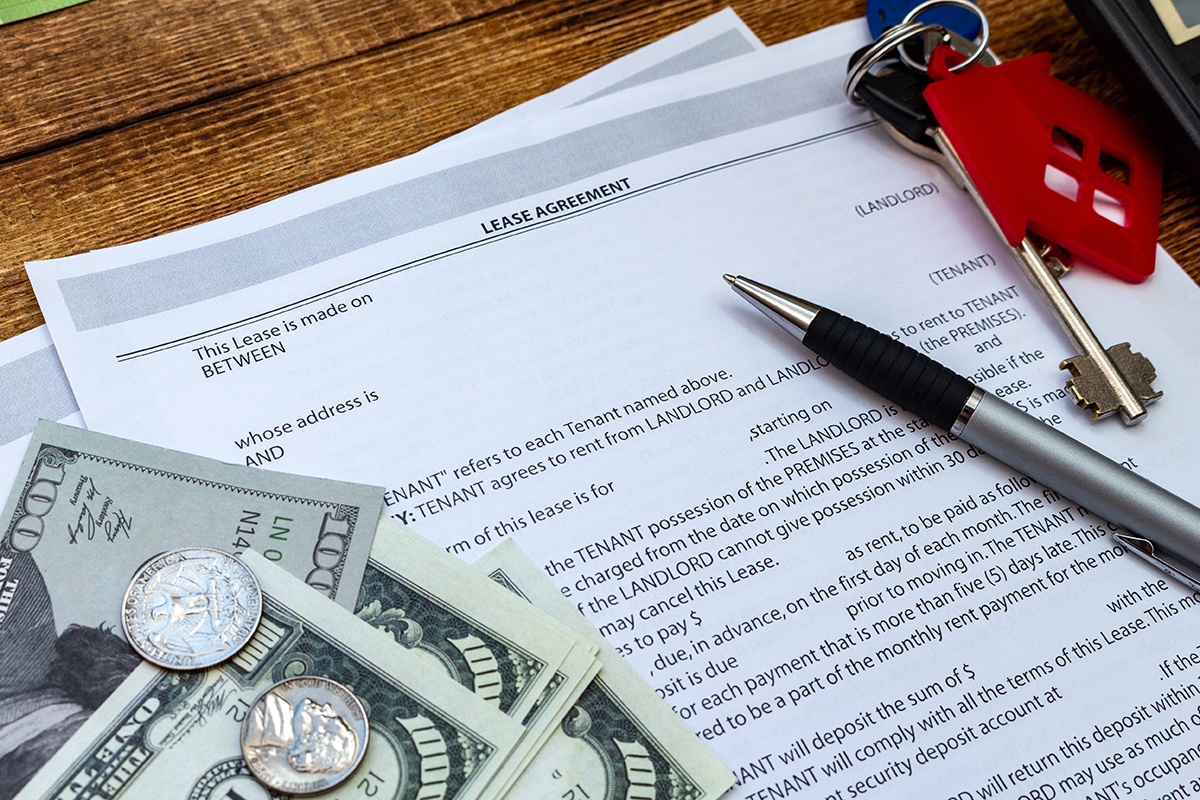To ensure property owners and tenants are protected under Wisconsin tenancy laws, they must enter into a lease agreement when renting property. The lease is formed when the first party (the “lessor”) and a second party (the “lessee”) agree on a specific rental period, rent amount, lease term, etc. Then, both parties sign a single agreement for all property types to officiate and make the document legally binding.
A Wisconsin lease agreement will generally include the following information to comply with Federal law:
- Identification of both parties (landlord and tenant)
- A legal description of the rented property and the appropriate address
- Regulations regarding pet keeping within the premises
- Necessary information about probable safety and health risks during the tenancy
- Monetary consideration terms include rent amount, due date, security deposit (if any), payment methods, etc.
This article will highlight these requirements and discuss the different types of lease agreements property owners and renters can expect within Wisconsin.
Wisconsin Lease Agreement
A Wisconsin lease agreement is between the lessor (such as a landlord) and the lessee (usually a tenant or person renting the property).
It lays out the terms of tenancy for both parties. The lessee agrees to stay in an apartment, condo, or home managed by the lessor for a certain amount of time and, in return, makes monthly payments. Lease agreements are used for both commercial and residential property. It is crafted after the tenant’s application has been approved after screening their qualifications, such as credit and employment status. The tenancy can then commence on the set date after the tenant has paid the 1st month’s rent and security deposit.
Agreement by Types
Lease agreements in Wisconsin will vary based on the type of property leased, the nature of the agreement, and other aspects. As a result, some of the different types that are commonly used are:
Association of realtors

It is a lease agreement designed by the Wisconsin Association of Realtors to manage the rented property. It is a standard form that contains the same information as a residential one. Its execution is governed by Chapter 704 (Landlord & Tenant). It should have a move-in/move-out inspection disclosure, allowing landlords to inspect the premises to record pre-existing damages. However, the landlord must issue a notice seven days before the inspection.
Commercial lease agreement
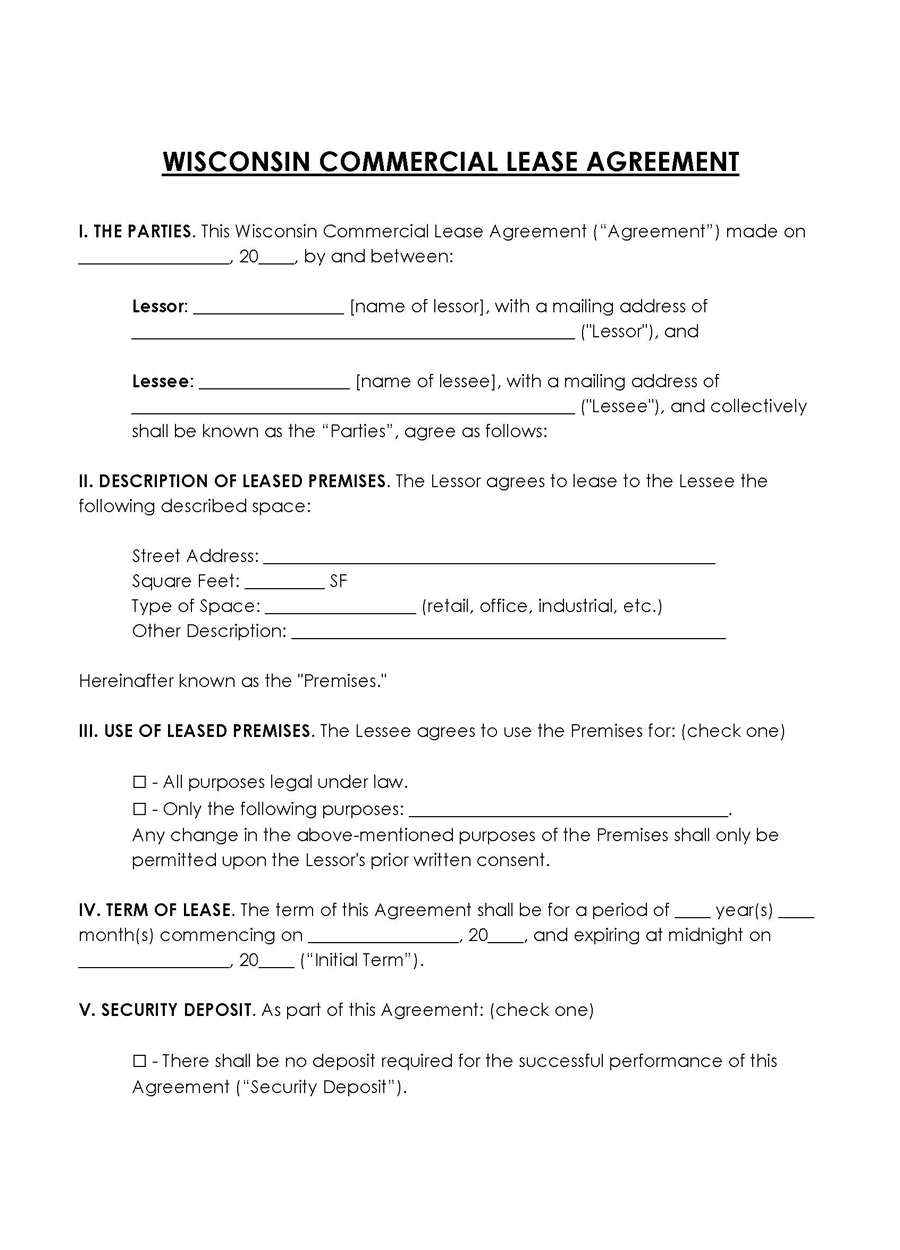
This lease agreement is designed for commercial property such as office space, retail stores, and warehouses. It falls under Chapter 411: Wisconsin Uniform Commercial Code of Wisconsin statutes governing renting units. It must outline all the pertinent details, and a lawyer can be consulted should specific clauses become incomprehensible. A commercial lease agreement ought to be notarized once completed and signed by both parties.
Month-to-month lease agreement
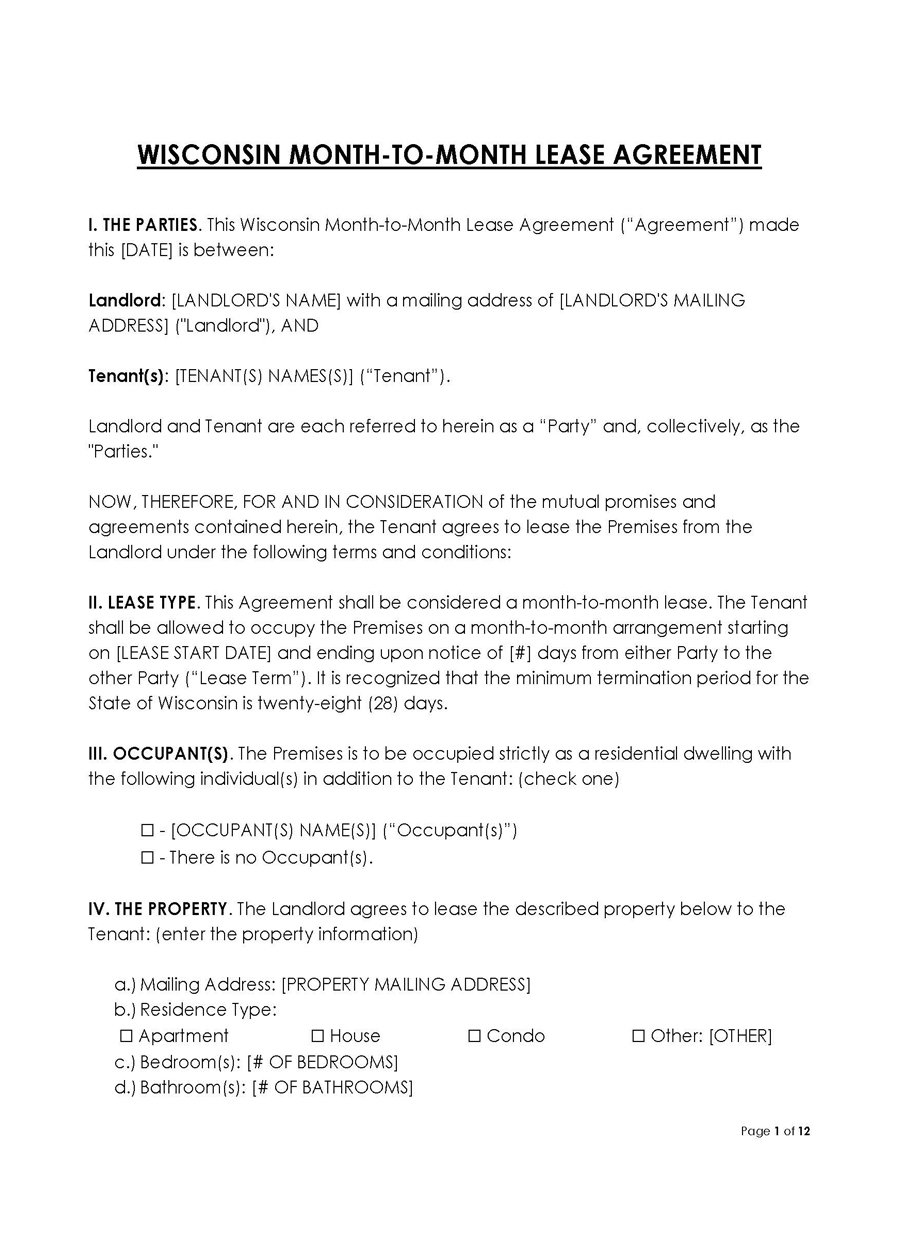
A month-to-month lease agreement is used for homes and apartments when tenants use the property as their primary residence. Either party can terminate the lease upon notice for at least 28 days. The notice must be issued with a method such as certified mail, where a receipt can be ascertained through a return receipt. This type of lease progresses until either party opts to terminate it. Its execution is governed by § 704.19.
Rent-to-own lease agreement
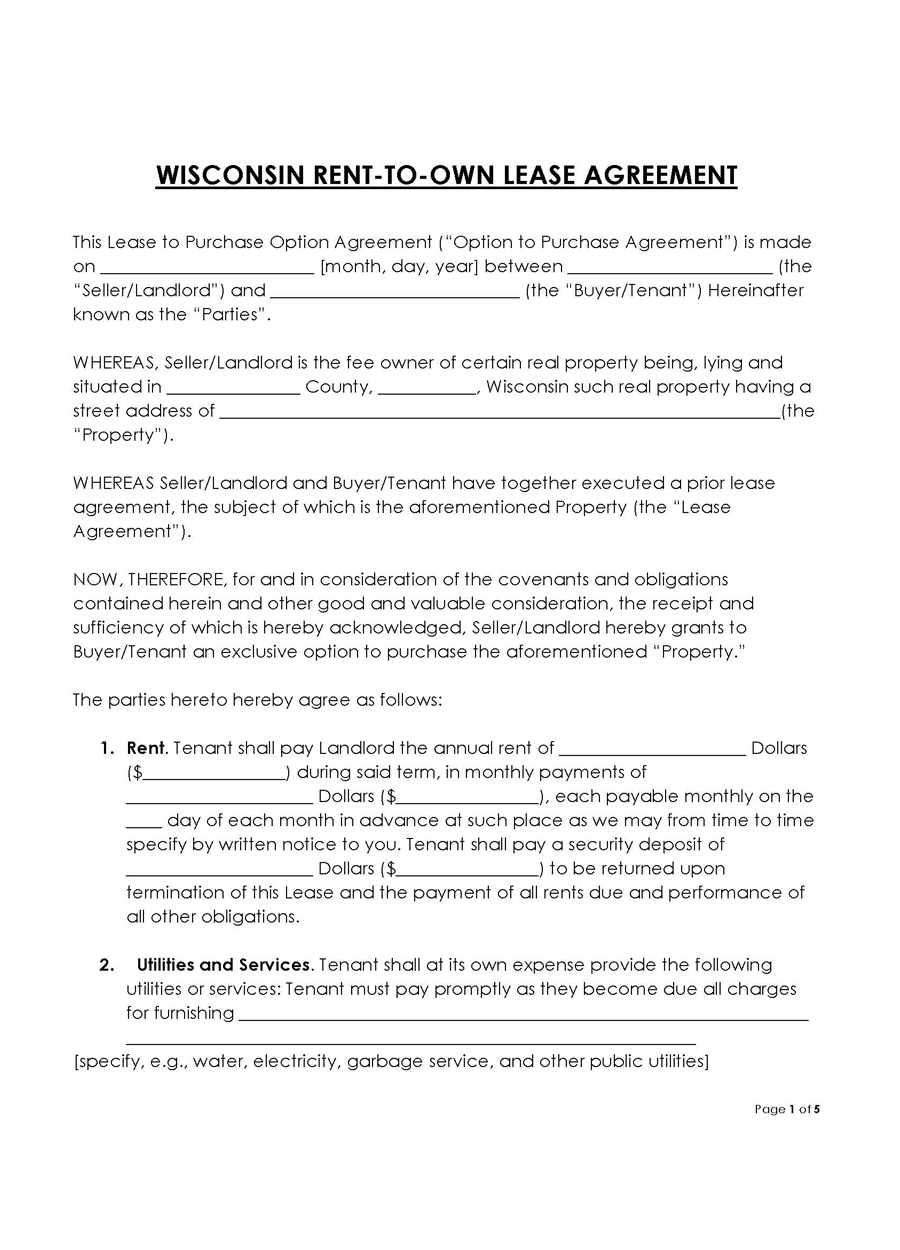
A rent-to-own lease agreement outlines the fundamental terms and conditions of the property with an option-to-buy clause, allowing the tenant to buy the property later. However, suppose the tenant doesn’t wish to purchase the property. In that case, it is executed as a standard lease without an obligation to buy and converts to a purchase contract if the tenant activates the option to purchase.
Roommate lease agreement
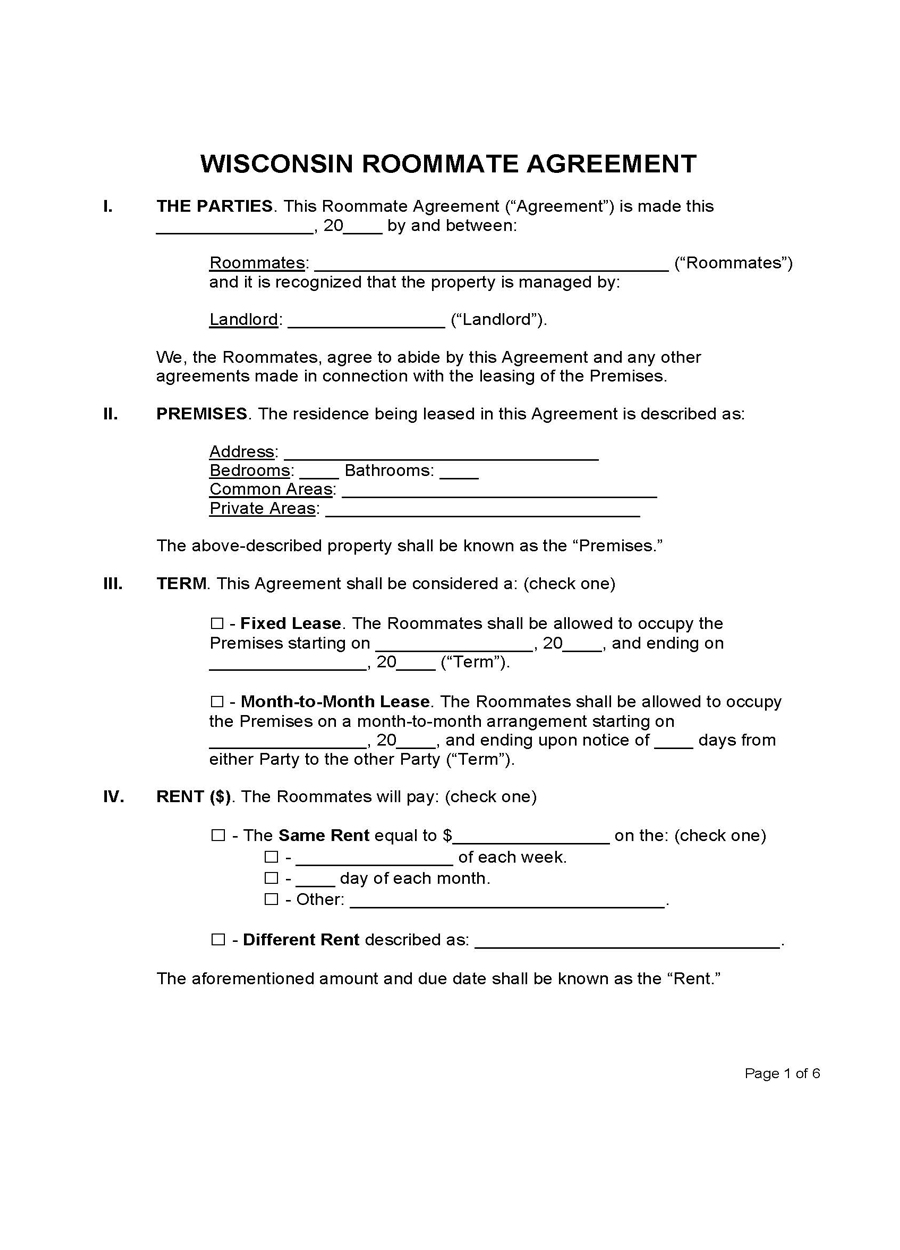
A roommate agreement is a contract between two or more tenants to live in the same dwelling. It will lay down the basics of tenancy, such as who pays for utilities, lawn care, chores, and other expenses for renting a room or unit.
Standard lease agreement

A standard lease agreement is a standardized contract used in different situations. It is typically used for leases with a fixed termination date, often one year. It contains clauses outlining the terms and conditions of leasing a property and is governed by Wisconsin statutes, Chapter 704 (Landlord & Tenant). (§ 134.06) states that a move-in checklist must be issued to the tenant and filled out within seven days if the landlord collects a security deposit for the rental unit. The checklist records any pre-existing defects and damages to the premises.
Sublease agreement

A sublease agreement is designed when a tenant wishes to offer a rental unit’s occupancy rights to another person (known as a sub-lessee/sub-tenant). It must be signed by each party, i.e., the tenant, the sublessee, and the landlord. In addition, this agreement must contain provisions stipulated in the original agreement between the property owner and the first tenant. As a result, the sub-lessor remains liable to the property owner for the entire lease term. Subleasing must, however, be carried out with the landlord’s written consent.
Required Disclosures
A lease agreement is meant to protect the interests of the lessor and lessee. Consequently, certain disclosures should be made in the document to foster a healthy landlord-tenant relationship.
Below are distinct disclosures that should be considered when preparing one:
Landlord and agent identification
A landlord must include their name, address, and telephone number in their agreement with the tenant. A tenant should also know the agent’s name, address, and telephone number if an agent is managing the property. This disclosure is meant for all rental units.
Lead-based paint
While preparing the lease agreement, landlords must also disclose information about lead-based paint risks. This disclosure is mandatory for buildings constructed before 1978. This disclosure obligates the landlord to complete a lead-based paint disclosure form, issue an EPA-approved pamphlet detailing lead-based paint hazards, and provide any existing reports or records of existing lead-based paint on the premises. These records and reports must be from building-wide evaluations for buildings with multiple units with shared common areas.
Move-in checklist
All tenants have the right to request a move-in checklist or inspection form from the landlord. The form should be completed and returned to the tenant within seven days after the lease commencement date. The checklist should include any existing damages, the condition of building components, and any health and safety hazards present on the property.
Domestic abuse protection
All Wisconsin landlords are obligated to declare if they have a policy that protects tenants from domestic violence. In addition, the landlord discloses the tenant’s rights under Wisconsin law and the terms and conditions of any physical abuse, such as protection orders and access procedures.
Building code violation
Landlords are obligated to disclose any existing code violation that affects the habitability of the premises and may clarify the nature and extent of the violation. The violation must also be declared if it poses safety and health risks or is past the deadline for curing notice.
Examples of violations that should be disclosed include structural hazards, a lack of hot/cold running water, faulty plumbing and sewerage systems, unsafe electrical connections, and a lack of heating systems to sustain liveable temperatures. Copies of the notice of violation can be attached as disclosure.
Damage and defect
Landlords are expected to disclose any existing damage or defects to any property where a security deposit was charged. Consequently, the tenant has the right to inspect the property, challenge this disclosure, and request a written checklist from the landlord outlining damages.
Shared utility adjustments
All lease agreements for any rental units with shared utilities must declare if any utility adjustments are shared among tenants. The amount each tenant will pay will be adjusted accordingly. The adjustment explains how shared utility charges will be paid and ensures that no tenant bears most of the costs. The landlord is to determine an appropriate system for sharing these costs, whether it is an equitable share or by square footage.
Non-standard rental provisions
Non-standard rental provisions should be disclosed and discussed. This includes stipulations on the maintenance of the property. When utilities are turned off, the length of notice required to terminate a lease, the rights of pets and animals, and any other information that will affect the tenant’s rental rights The non-standard disclosure must be agreed upon, signed, or initialized.
Late and returned check fees
Any applicable late and returned check fees should be disclosed in the lease agreement. Wisconsin restricts landlords from charging a specific amount, but the set fee should be reasonable and justifiable.
Typically, a maximum of 10% of the rent is acceptable and must be compared with the costs incurred due to the inconvenience caused by late payments. In addition, the disclosure must specify that this fee is only applicable after the grace period, which is five days after the due date.
Bed bug disclosure
The agreement can contain a disclosure detailing whether the rental unit has previously had bed bug infestations or not. The exact instructions and procedures regarding bed bug inspection and handling should be set out as well. This disclosure should convey the tenant’s responsibility to report any signs of infestation as soon as possible.
Asbestos disclosure
A landlord’s disclosure of asbestos-related hazards must be provided for any building constructed before 1981. If the unit contains asbestos, the disclosure must include a description of how to handle this material to prevent exposure or harm. It is also important to disclose if repairs, modifications, sanding, etc., have ever been made to the building.
Mold disclosure
If the rental unit contains any signs or has a history of mold, then the landlord is expected to disclose this to the tenant. It should explain that mold is highly detrimental to health and property and how it can be remedied. The agreement must also specify how tenants can report if they ever observe any symptoms like water damage or other indications of mold growth. The disclosure should also indicate the current mold status of the rental unit to be referenced in case of future liability due to mold damages.
Landlord and Tenant Laws
Landlord and tenant laws provide particular rights to both parties. Landlords have a right to timely payments, free and clean premises, and a safe environment. Tenants have a right to protection against discrimination, health hazards on the property, accurate disclosures of defects, and any pet restrictions. Multiple other aspects of leasing are subject to landlord-tenant laws in Wisconsin.
For example:
Right of entry
An entry by the landlord into the premises can be made only with the tenant’s consent. The Wisconsin law provides that landlords must give adequate notice (in most cases, at least 12 hours’ notice) and should use reasonable methods to enter a residence for general access (§ 704.05(2)). However, in emergency cases and during the tenant’s absence, the landlord can enter the rental unit without notice.
Rent
Wisconsin laws govern certain aspects of rent, such as the grace periods, rent increases, and maximum fees. A grace period can be imposed on the lease, which must be agreed upon and outlined in the agreement (§ 134.09(8)). Any fees charged to the tenant must be declared in the agreement, but there is no limitation on how much can be charged (§ 134.09(8)). According to a Guide for Landlords and Tenants, landlords cannot increase rent before the lease expires, but no law governs rent increases.
Security deposit
Landlords can opt to request a security deposit if they wish; there is no statute of limitation. However, according to § 134.06(2), landlords must refund the security deposit 21 days after the tenant moves out. In addition, if a security deposit is charged, the tenant must be allowed to inspect the rental unit within seven days after the commencement of the lease.
Wisconsin Lease Agreement Templates
Conclusion
Landlord-tenant laws in Wisconsin provide fair treatment between the parties. A properly drafted lease agreement can put the policies and limitations into effect. This guide is a concise compilation of information to serve as a resource for those who are drafting or reviewing rental agreements. As an owner or tenant, each party must ensure that their agreement complies with all laws and regulations set by the state of Wisconsin.
The main things to look out for include mutuality of obligations, the landlord’s compliance with basic state laws, and explicit language that creates no confusion about what you are signing up for.






